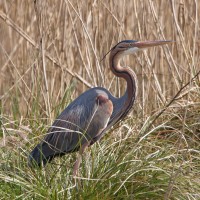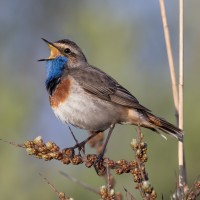Description
Tiendweg, named after the road on the southern side of the area, is an area within a large typical peat meadow landscape, called "Polder de Nesse". The area consists of a mixture of intensive and (narrow) extensive pastures on which cattle is held. The area is surrounded by a large ditch in which many waterfowl are present, like Tufted Duck, Gadwall and large numbers of Eurasian Coot. Also Little Grebe and Great Crested Grebe are present. In the smaller ditches between the pastures, species like Common Teal, Garganey and Northern Shoveler are found. In spring and summer, herons, like Purple Heron and Grey Heron hunt for frogs. Common Tern and small numbers of Black Tern can be seen hunting above the ditches after which they return to their nests in the surrounding area.
During the breeding season, the pastures are used as breeding habitat for several species of waders, like Black-tailed Godwit, Common Redshank, Northern Lapwing and Eurasian Curlew. Besides waders, species like Eurasian Skylark, Meadow Pipit and Western Yellow Wagtail also breed here. Northern Wheatear is often seen on the pastures during migration. Western Marsh Harrier hunts above these pastures. Often, Peregrine Falcon can be seen on the power lines, overlooking the area. In the northern part, a small forested area is present in which Common Buzzard breeds. Also Eurasian Goshawk has been spotted here multiple times, and maybe even breeds there. On the fences surrounding the pastures, species like European Stonechat can be spotted.
On the southwestern edge, the area is adjacent to the village of Ouderkerk aan den IJssel. There's a small park which is used by many common species of songbird. Especially during autumn migration, species like Firecrest and Goldcrest can turn up here. Also Common Kingfisher can be seen around the large ditch in this corner.
On the northeastern part of the area, a "boezem" is present, called "Berkenwoudsche Lage Boezem". This type of landscape is used to collect water from the surounding pastures and dispose it off towards a river, in this case the "Hollandsche IJssel" river. The "boezem" consists of mainly wetland area with low forested parts and local reedbeds. The area attracts many waterbirds, but is especially good for waders during migration. Common species are Common Redshank, Common Greenshank, Ruff and Common Sandpiper, but also scarcer species can be present here, like Spotted Redshank, Dunlin and Grey Plover. In the reedbeds, common species of reedbird breed, like Sedge Warbler, Reed Warbler, Bluethroat and Reed Bunting. If you're lucky, a Savi's Warbler or Cetti's Warbler can be heard. In the smaller bushes, species like Icterine Warbler and Lesser Whitethroat can be present.
In winter, the area is mainly used by large flocks of geese and swans, like Greater White-fronted Goose, Barnacle Goose and Mute Swan, and larger numbers of Great Egret can be present. Sometimes Hen Harrier uses the area as foraging habitat.
Details
Access
The area is easy accessable on foot, by bike and by car. The tarmac road on the southern part of the area leads to a deadend, but you can park your car at the end of the road. The best way to observe de area is to use the car and stop often to check the surrounding area until you reach the bicycle road at the end (dead end for cars). From there, you can make a walk next to the "boezem" to observe the wet areas on the other side of the large ditch. You can start or end with the park on the southern part of the area to look for migrants during migration.







